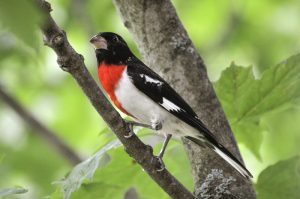Transitioning Your Yard to Native Plants: Why?

As the weather finally begins to warm, we expect many will be spending some time working on their outdoor spaces. If you are looking to do some landscaping around your home this season, you may want to consider starting to transition your yard to native plants. The impending impacts of climate change will find birds and wildlife ranges shifting northwards, and will also increase our prospects for experiencing severe weather events. Using native plants in your landscaping can provide many benefits including support for local wildlife and making your home more resilient.
What are the benefits of using Native Plants?
Flood prevention and erosion control
As a rule, native plants, trees and shrubs establish strong, deep root systems that are not found with lawn grasses and sod. These root systems can help to reduce the flooding impacts from major storm systems by storing water during and after heavy rains. They are also more effective at slowing water down and therefore reducing erosion and loss of soil on your property. Avoiding flood damage can reduce your insurance claims on your homeowners policy. Claims on your insurance will typically result in increased rates over time, so therefore, this is an investment that could save you money in the long run.
Increased habitat and less maintenance
Native plants naturally require less fertilizers and pesticides to keep them healthy and once they are established, they require less watering and maintenance than a grassed lawn. In addition, they provide important sources of food and shelter for birds, insects and local wildlife. Habitat loss is the number one threat to birds and other wildlife, so every patch we can create is an oasis of much needed space. Over the past century, the US has lost over 150 million acres of habitat and farmland – a trend that shows no sign of slowing. Converting our lawns can help reclaim over 40 million acres of needed habitat. Native animals rely on local plant species – for cover from predators and protection from the elements as well as for nuts, seeds, berries and insects that they host.
Healthy ecosystems and beautiful spaces
From an ecological perspective, native plants help to maintain the integrity of the ecosystem and they can help to reduce the spread of invasive species. They can also be a beautiful addition to your property as many native plants produce showy flowers, abundant fruits and seeds, and brilliant fall foliage. They are healthy places where you and your family can spend time.
(To be continued in Part 2: Transitioning Your Yard to Native Plants: How?)

